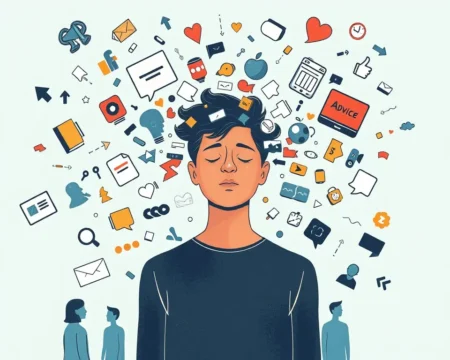Digital mental health interventions (DMHIs), offering a promising avenue to expand access to mental healthcare, are facing a significant challenge: low user engagement. While these interventions have demonstrated the potential to reduce symptoms of depression and anxiety, their effectiveness is often hampered by high dropout rates and inconsistent usage, according to recent studies.
The Promise and the Problem of Digital Mental Health
In recent years, digital mental health interventions have emerged as a potential solution to address the growing need for mental health support. These interventions, delivered through websites, mobile apps, and other digital platforms, offer a range of services, including:
- Therapy programs: Cognitive behavioral therapy (CBT) and other evidence-based therapies delivered online.
- Mood tracking: Tools for monitoring and managing mood and emotional states.
- Meditation and mindfulness exercises: Guided practices for stress reduction and emotional well-being.
- Peer support: Online forums and communities for connecting with others facing similar challenges.
DMHIs hold particular promise for young people and individuals in low- and middle-income countries, where access to traditional mental health services may be limited. They offer convenience, affordability, and anonymity, potentially reducing barriers to seeking help. The COVID-19 pandemic further accelerated the shift towards digital mental health care, highlighting its potential to provide safer alternatives to face-to-face treatment.
However, the effectiveness of DMHIs hinges on user engagement, and this is where a major challenge lies. Studies consistently show that many users fail to complete digital mental health programs, with dropout rates exceeding 70% in some cases. Low engagement not only limits the potential benefits for individuals but also hinders the widespread adoption of DMHIs in healthcare settings. Health professionals remain hesitant to fully embrace digital interventions until they are convinced of their viability as an adjunct or alternative to traditional therapies.
Why Are Users Disengaging? Key Barriers
Several factors contribute to low user engagement with digital mental health interventions. Understanding these barriers is crucial for developing more effective and engaging programs. Some of the key challenges include:
- Severity of mental health issues: Individuals with severe depression, low mood, or fatigue may lack the motivation or energy to consistently engage with digital interventions.
- Lack of personalization: Generic programs that do not address individual needs and preferences are less likely to hold users’ attention.
- Technical issues: Technical difficulties, such as software glitches or poor user interface design, can frustrate users and lead to disengagement.
- Lack of support: The self-help nature of many DMHIs can be isolating, and users may benefit from personalized support, coaching, or peer interaction.
- Integration into daily life: Users may struggle to find the time or a private space to engage with digital interventions, making it difficult to integrate them into their daily routines.
- Doubts about effectiveness: Negative beliefs about mental health services or technology can hinder engagement.
- Digital illiteracy: Lack of comfort or experience with technology can be a barrier for some users.
- Time constraints: Many users find it difficult to dedicate enough time to fully engage with the intervention.
A recent systematic review identified several factors related to the end user, the program content, and the technology itself that act as barriers, including severe mental health issues, technical problems, and lack of personalization.
Strategies for Boosting User Engagement
To overcome the challenge of low user engagement, developers and researchers are exploring various strategies to make digital mental health interventions more appealing and effective. Some promising approaches include:
- Personalization: Tailoring interventions to individual needs, preferences, and cultural backgrounds can significantly improve engagement. Mental health apps that utilize data-driven insights to create tailored content significantly increase user retention.
- Gamification: Incorporating game-like elements, such as points, badges, and leaderboards, can increase user motivation and make the intervention more enjoyable.
- Personalized support: Providing personalized support through e-coaching, peer support platforms, or video conferencing can create a sense of connection and accountability.
- Reminders and notifications: Automated reminders and notifications can help users stay on track with the program and prevent them from forgetting to engage.
- Flexible scheduling: Allowing users to book video sessions at times that work best for them increases accessibility.
- User-centered design: Involving users in the design and development process can ensure that the intervention is user-friendly and meets their needs.
- Integration with social networks: Connecting DMHIs with social networks can foster a sense of community and provide opportunities for peer support.
- Clear progress tracking: Helping users visualize their progress and see the benefits of the intervention can increase motivation.
- Simplified interfaces: A simple, low-effort digital interface is essential for maintaining engagement, especially for those with severe symptoms.
- Addressing digital poverty: Providing devices and internet access to those who lack them can ensure equitable access to DMHIs.
Studies have shown that engagement strategies such as reminders, coaching, and tailored feedback delivered via telephone or email can have modest to moderate effects on increasing engagement with digital interventions. Personalized support, access to social support, and personalized feedback appear to promote engagement with digital interventions for mental health promotion.
The Importance of User Involvement in Design
User involvement in the design and development of DMHIs is crucial for increasing their implementation success. Three primary methods of engaging users are:
- User-centered design: Focuses on understanding user needs and preferences through research and testing.
- Participatory or co-design: Involves users as active partners in the design process.
- User innovation: Empowers users to create their own solutions and adapt existing interventions to their needs.
Co-design may be a better option for at-risk populations, as it can identify potential barriers and bolster facilitators to uptake and engagement.
The Digital Cumulative Complexity Model
The digital cumulative complexity model (DiCuCoM) highlights the interplay between a patient’s workload of demands and their capacity to manage this workload. It considers the burden of illness, the burden of current life circumstances, and the burden placed upon them by the DMHI. Factors associated with reduced DMHI engagement include higher symptom severity or complexity and lack of motivation.
Looking Ahead: Maximizing the Potential of Digital Mental Health
Digital mental health interventions have the potential to transform mental healthcare by increasing access, reducing costs, and empowering individuals to take control of their well-being. However, overcoming the challenge of low user engagement is essential to realizing this potential.
Moving forward, it is crucial to:
- Invest in research: Further research is needed to identify the most effective engagement strategies and to understand the factors that influence user behavior in digital mental health settings.
- Develop evidence-based guidelines: Establishing clear guidelines for the design, development, and implementation of DMHIs can ensure that they are effective, safe, and user-centered.
- Promote collaboration: Collaboration between researchers, developers, clinicians, and users is essential for creating digital mental health interventions that meet the needs of diverse populations.
- Address ethical considerations: Privacy concerns, data security, and the potential for digital exclusion must be carefully considered to ensure that DMHIs are used responsibly and ethically.
By addressing these challenges and embracing innovative solutions, we can unlock the full potential of digital mental health interventions and create a future where mental healthcare is accessible, affordable, and effective for all.










